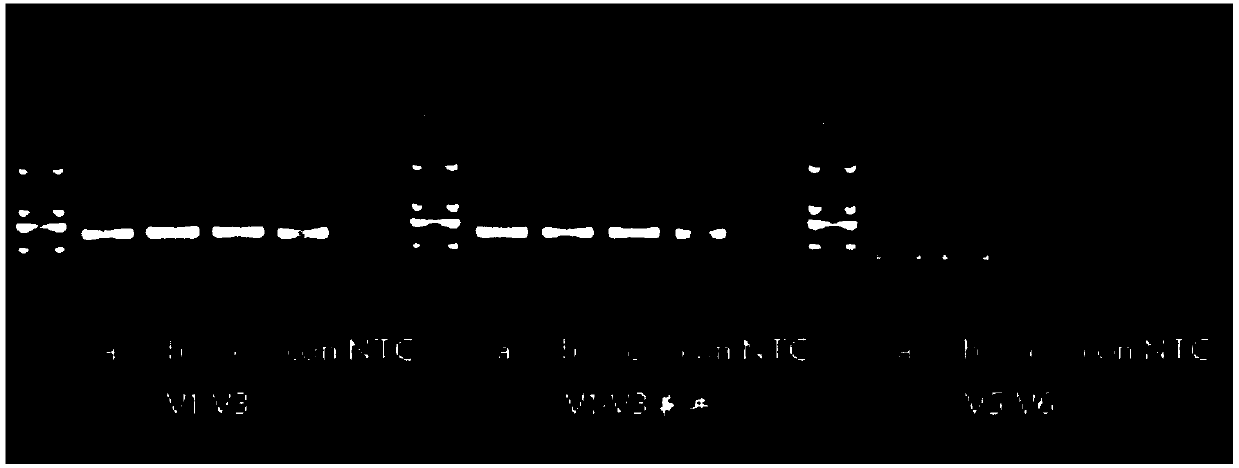Tracing method of probiotics in dairy product
A technology of probiotics and dairy products, applied in the field of detection, can solve the problems of not including probiotics, poor DNA extraction effect, unsatisfactory test results, etc., and achieve the effect of improving the effect
- Summary
- Abstract
- Description
- Claims
- Application Information
AI Technical Summary
Problems solved by technology
Method used
Image
Examples
Embodiment 1
[0083] Example 1: Different primers detect probiotic standard
[0084] A traceability method for probiotics in dairy products, comprising the following steps:
[0085] (1) Sample pretreatment: Take 1g of mixed probiotic standard, dissolve in 10mL ddH 2 In O, add 1 mL of 18% sodium citrate and 500 μL of 1mol / L sodium hydroxide, mix and centrifuge at 12,000 r / min for 10 min, discard the supernatant, and add 180 μL of lysozyme to the precipitate for incubation;
[0086] (2) The processed samples were extracted with Tiangen Bacteria Genomic DNA Extraction Kit to extract the whole genome DNA of probiotics;
[0087] (3) 16S rRNA PCR amplification: Aiming at the v1-v3 region of bacterial 16s rDNA, use SEQ ID NO.1-6 primers to perform PCR amplification respectively;
[0088] The nucleotide sequence of the primer is as follows:
[0089] 27F (SEQ ID NO.1): 5'-AGAGTTTGATCCTGGCTCAG-3';
[0090] 543R (SEQ ID NO.2): 5'-ATTACCGCGGCTGCTGG-3';
[0091] 27F' (SEQ ID NO.3): 5'-AGRGTTYGATYCT...
Embodiment 2
[0108] Example 2: Analysis of 16S rDNA library construction of standard probiotics
[0109] (1) PCR product purification
[0110] After the electrophoresis detection is correct, use AxyPrep TM PCR Clean-Up Kit is used for column purification and recovery of PCR products. First add 3 volumes of buffer buffer PCR-A to the PCR product (if the buffer PCR-A is less than 100uL, add to 100uL); put the preparation tube into a 2mL centrifuge tube, add 700μL buffer W2, 12,000Xg for 1min , discard the filtrate; put the preparation tube into a centrifuge tube, add 400 μL of buffer buffer W2, and centrifuge at 12,000 rpm for 1 min; discard the filtrate, and spin at 12,000 rpm for 1 min to elute the DNA.
[0111] (2) Mixed library and on-machine sequencing
[0112] The 16S rRNA sequences corresponding to the recovered samples were uniformly mixed, the library was constructed using the Illumina DNA Fragment Library Construction Kit, the library was quantified by the Qubit method, and the ...
Embodiment 3
[0122] Example 3: Detection of actual samples with degenerate primers
[0123] A traceability method for probiotics in dairy products, comprising the following steps:
[0124] (1) Sample pretreatment: Take 1g of mixed probiotic standard, dissolve in 10mL ddH 2 In O, add 1 mL of 18% sodium citrate and 500 μL of 1mol / L sodium hydroxide, mix and centrifuge at 12,000 r / min for 10 min, discard the supernatant, and add 180 μL of lysozyme to the precipitate for incubation;
[0125] (2) The processed samples were extracted with Tiangen Bacteria Genomic DNA Extraction Kit to extract the whole genome DNA of probiotics;
[0126] (3) 16S rRNA PCR amplification: Aiming at the v1-v3 region of bacterial 16s rDNA, use SEQ ID NO.3-4 primers to perform PCR amplification respectively;
[0127] The nucleotide sequence of the primer is as follows:
[0128] 27F' (SEQ ID NO.3): 5'-AGRGTTYGATYCTGGCTCAG-3';
[0129] 543R' (SEQ ID NO.4): 5'-ATTACCGCGGCTGCTGG-3';
[0130] The specific amplification...
PUM
 Login to View More
Login to View More Abstract
Description
Claims
Application Information
 Login to View More
Login to View More - R&D
- Intellectual Property
- Life Sciences
- Materials
- Tech Scout
- Unparalleled Data Quality
- Higher Quality Content
- 60% Fewer Hallucinations
Browse by: Latest US Patents, China's latest patents, Technical Efficacy Thesaurus, Application Domain, Technology Topic, Popular Technical Reports.
© 2025 PatSnap. All rights reserved.Legal|Privacy policy|Modern Slavery Act Transparency Statement|Sitemap|About US| Contact US: help@patsnap.com



